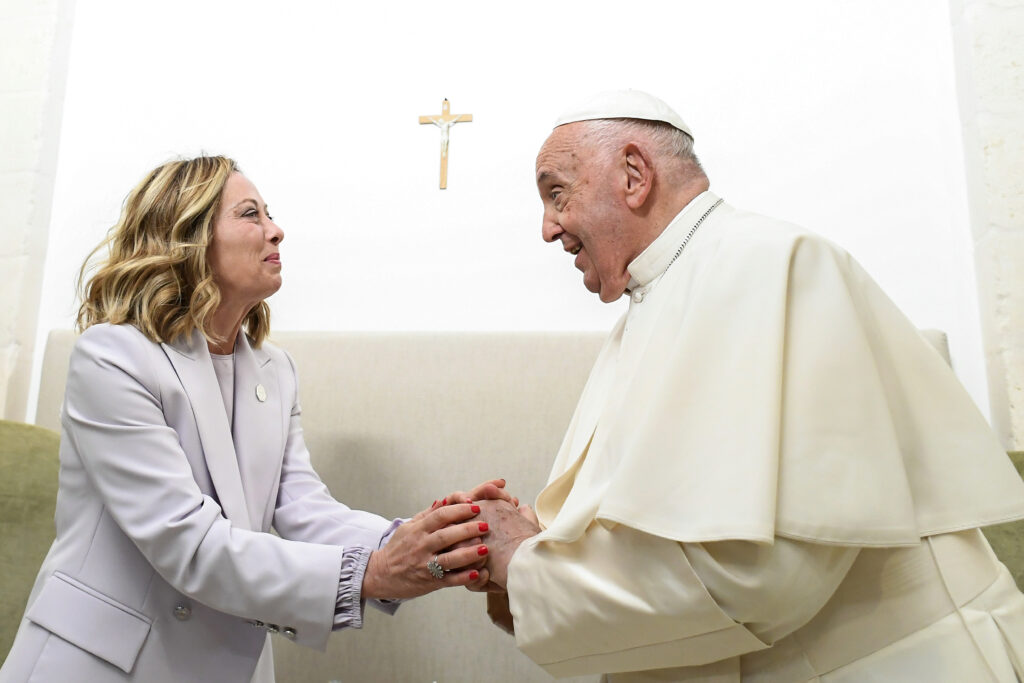Analyses
28 April 2025
Italy–Vatican: Between Institutional Proximity and Ideological Divides

The Italian Republic suspended all official activities until the funeral of the Holy Father, which took place this Saturday. While Pope Francis was the spiritual leader of Catholics worldwide, he was also the head of state of the smallest country in the world, located at the very heart of Rome: the Vatican. Relations between Italy and the Holy See are long-standing and complex, blending spirituality, politics, history, and interests (sometimes divergent). Since the Italian unification in the 19th century, these ties have been marked by tensions – notably the territorial question – until the signing of the Lateran Accords in 1929. Despite sometimes profound ideological differences, the Church and the Italian State have never truly broken off dialogue, evidence of the enduring influence of Catholicism in Italian society.
The Lateran Accords, the Foundation of the Relationship Between the Two States
The Lateran Accords, signed on 11 February 1929 by Benito Mussolini, the Holy See, and Cardinal Gasparri on behalf of Pope Pius XI, marked a major turning point in the relationship between the two entities. They brought an end to the “Roman Question”, opened in 1870 when Italian troops annexed Rome and ended the Papal States. For almost sixty years afterwards, the Popes refused to recognise the legitimacy of the new Italian State.
The Lateran Accords stabilised relations between the two countries across three main axes: firstly, a political treaty by which Italy recognised the independence and sovereignty of the newly created State of the Vatican City. This treaty also guaranteed the Church a series of privileges, notably extraterritoriality for certain major basilicas and residences (such as the Lateran, Santa Maria Maggiore, or Castel Gandolfo), as well as full immunity for ecclesiastical authorities on these sites. The accords also included a financial convention, through which Italy committed to compensating the Holy See for the loss of the Papal States. The Vatican thus received a sum of 1.75 billion lire (partly in cash, partly in government bonds), enabling the Papal State to establish a solid financial base. Finally, a religious concordat established Catholicism as the state religion and conferred a predominant role upon the Church in Italian society, a legacy that persists to this day.
These accords marked a strategic alliance between the Church and the Fascist regime. In exchange for the recognition of the Vatican, Benito Mussolini obtained the tacit support of the Church, which saw in the regime a bulwark against communism. The Church, in turn, secured a powerful institutional status within unified Italy. A marriage of convenience and interest rather than a true political agreement desired by both parties. Despite the fall of Fascism and the return of the Republic in 1946, the Lateran Accords remained in force. Even today, they constitute the legal framework governing relations between the Holy See and the Italian State.
A Church Still Influential in Contemporary Italy
The Lateran Accords have been revised: since 1984, Catholicism is no longer the state religion in Italy. Nevertheless, the influence of the Church remains significant. Religious education, although optional, is still offered in secondary schools. Several Italian laws continue to reflect this influence.
The first concerns blasphemy, which constituted a criminal offence (Article 724 of the Penal Code) until 1999. It is now considered a minor infraction, punishable by a fine (ranging from €51 to €309). It is rarely sanctioned, as in some regions (such as Veneto), blasphemy forms part of everyday language and controlling it is almost impossible. However, in the world of sport, the rule is more strictly applied: Article 37 of the Code of Sports Justice provides for a one-match suspension for any player caught blaspheming on the pitch, provided there is an audio recording to prove it. This was the case for Davide Lanzafame in 2010, the first footballer sanctioned for this reason.
The second concerns conscientious objection, particularly in the medical field. This provision allows practitioners to refuse to perform certain procedures, such as abortion. In some regions (such as Calabria), the rate of objecting doctors exceeds 90%, making access to voluntary termination of pregnancy (abortion) very difficult and forcing women to travel to other regions. This reality causes major imbalances in hospital planning. The same phenomenon is observed with the distribution of the morning-after pill, sometimes unavailable in certain municipalities due to a lack of doctors willing to prescribe it.
Finally, the Vatican benefits from very favourable tax conditions in Italy. The Church does not pay property tax on its real estate holdings, although the 2012 reform has somewhat limited this exemption. Moreover, each Italian taxpayer must allocate 0.8% of their taxes to an organisation of their choice. In the absence of a specific choice, this amount is automatically assigned to the Catholic Church, which thus received nearly one billion euros in 2024. Administratively, the Church retains certain authority: religious marriages are legally recognised, just like civil unions celebrated at town halls.
Political Tensions and Ideological Divides
Pope Francis regularly made statements opposing the Italian government on various issues. On the migration question, he declared: “God is with the migrants; rejecting them is a grave sin”, a statement in total contradiction with the rhetoric of the sovereignist right, which denounces an alleged “ethnic and cultural replacement”, in the words of Giorgia Meloni. Likewise, Francis adopted a neutral stance in the war in Ukraine, calling for peace, and showed solidarity with the population of Gaza in the Israeli-Palestinian conflict, contrasting with the hardline position of the Italian government.
In this context, the Italian sovereignist right has no choice but to defend Christian values through a civilisational lens. In 2021, Matteo Salvini declared that Pope Francis “was not [his] pope”, preferring Benedict XVI, who was more conservative. For Giorgia Meloni, it is the defence of Christian traditions that matters most, even if the figure of the Pope cannot be entirely dismissed.
Pope Francis’ funeral opened another controversy in Italy. The date of the ceremony coincided with one of Italy’s national holidays, the liberation from Fascism. The Minister for Civil Protection, Nello Musumeci, called on Italians to celebrate the day “with the moderation and sobriety the circumstances require.” For some, this was a way to limit anti-fascist demonstrations across the country, under the pretext of the funeral of Pope Bergoglio.
A Papal Election with Major Political Stakes
The choice of Francis’ successor will have a real impact in Italy. A progressive pope would strengthen the moral opposition to Meloni’s line, while a more conservative pontiff could foster a rapprochement. Giorgia Meloni, an adept of ideological confrontation, could exploit a reformist pope to bolster her own positioning. In a country where religious identity remains a political lever, the personality of the future pontiff may become a domestic political issue, used by various political forces to legitimise or contest government policies. In any case, the two states will, as they always have, have to navigate both their convergences and their disagreements to preserve a balance at the heart of the Italian peninsula.

